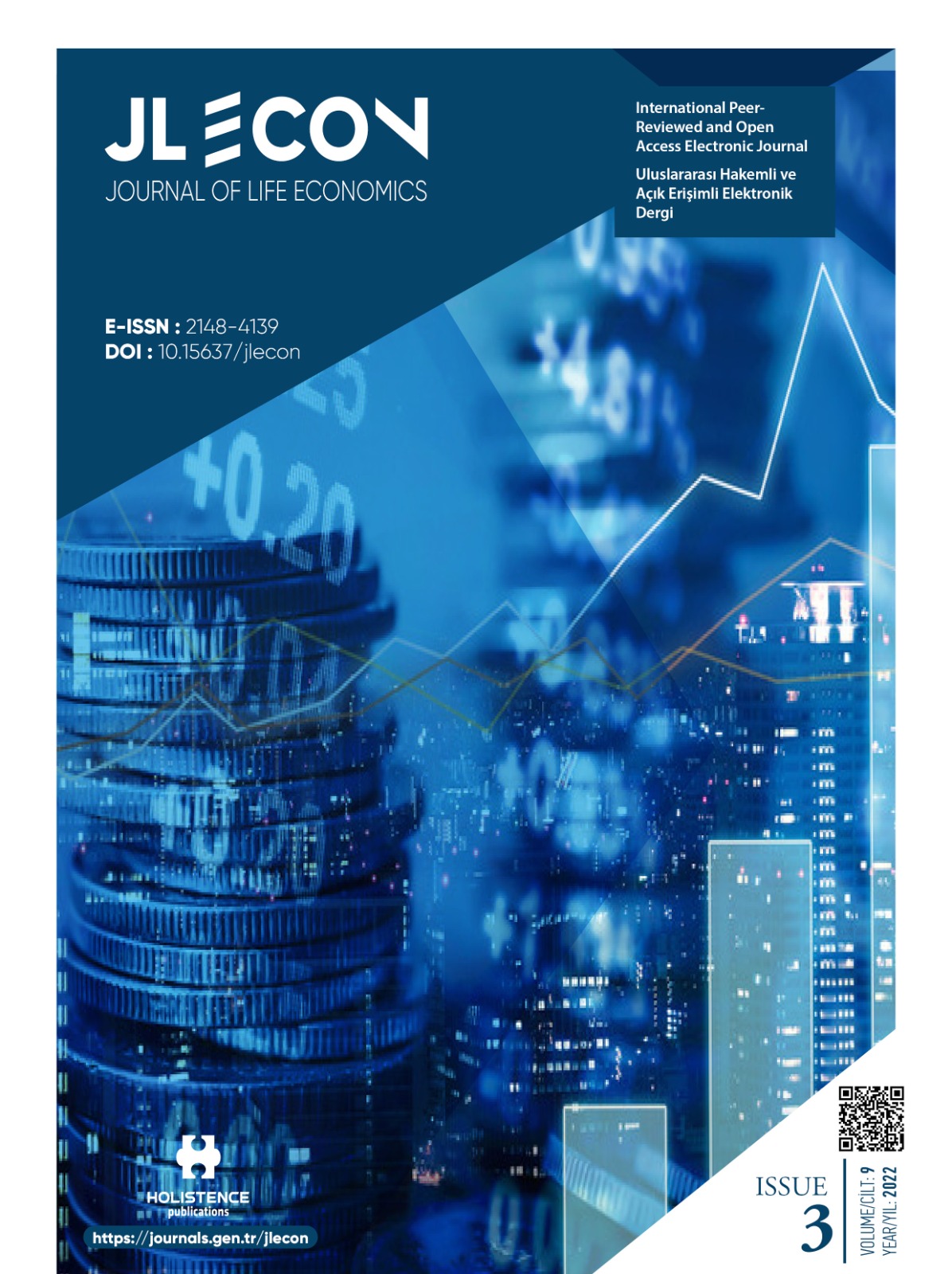The comparison of range-based volatility estimators and an application of TVP-VARbased connectedness
DOI:
https://doi.org/10.15637/jlecon.9.3.03Anahtar Kelimeler:
Diebold-Yilmaz Connectedness- HRMSE- Range-based volatility- TVP-VARÖzet
This paper aims to show the application of range-based volatility in connectedness analysis. For this purpose, we compare the volatility estimators Parkinson, Yang-Zhang, Garman-Klass, Rogers-Satchell, and modified Garman- Klass by Yang and Zhang methods. As an example, we calculated the range-based stock prices’ volatility of four defense industry companies quoted in Borsa Istanbul. We compared the forecast performance of volatility against Heteroskedastic Root Mean Square Error statistics. We include the best performing volatility series in the spillover analysis. Instead of the Cholesky decomposition VAR and generalized VAR approaches used in the calculation of the Diebold-Yılmaz connectedness index, we apply the TVP-VAR-based connectedness approach. The comparison results show that Rogers-Satchell for ASELSAN, KATMERLER, and PAPIL, and Parkinson volatility estimator for OTOKAR have the smallest error, respectively. The empirical findings of TVP-VAR connectedness show that the average forecast error variance of the network is 34.35%.
İndirmeler
Referanslar
ANTONAKAKIS, N., & GABAUER, D. (2017). Refined measures of dynamic connectedness based on TVP-VAR. MPRA Paper No. 78282.
ANTONAKAKIS, N., CHATZIANTONIOU, I., & GABAUER, D. (2020). Refined Measures of Dynamic Connectedness based on Time-Varying Parameter Vector Autoregressions. Journal of Risk and Financial Management, 13(4), 84. MDPI AG. Retrieved from http://dx.doi.org/10.3390/jrfm13040084
ARNERIĆ, J., MATKOVIĆ, M., & SORIĆ, P. (2019). Comparison of range-based volatility estimators against integrated volatility in European emerging markets. Finance Research Letters, 28, 118-124.
BALI, T. G., & WEINBAUM, D. (2005). A comparative study of alternative extreme‐value volatility estimators. Journal of Futures Markets: Futures, Options, and Other Derivative Products, 25(9), 873-892.
BAYRACI, S., & UNAL, G. (2014). Stochastic interest rate volatility modeling with a continuous time
GARCH(1, 1) model. Journal of Computational and Applied Mathematics, 259, 464–473. doi:10.1016/j.cam.2013.10.017
BOLLEN, B. (2014). What should the value of lambda be in the exponentially weighted moving average volatility model? Applied Economics, 47(8), 853–860. doi:10.1080/00036846.2014.98285
CHOU, R. Y. (2005). Forecasting financial volatilities with extreme values: the conditional autoregressive range (CARR) model. Journal of Money, Credit and Banking, Vol. 37, 561-582.
DIEBOLD, F.X., & YILMAZ, K. (2009). Measuring Financial Asset Return and Volatility Spillovers, with Application to Global Equity Markets. Economic Journal, 119, 158{171.
DIEBOLD, F.X., & YILMAZ, K. (2012). Better to Give than to Receive: Predictive Measurement of Volatility Spillovers. International Journal of Forecasting, 28, 57-66.
DIEBOLD, F.X., & YILMAZ, K. (2014). On the Network Topology of Variance Decompositions: Measuring the Connectedness of Financial Firms. Journal of Econometrics. 182, 119-134.
DIEBOLD, F.X., & YILMAZ, K. (2015). Financial and Macroeconomic Connectedness: A Network Approach to Measurement and Monitoring. Oxford University Press.
DIEBOLD, F.X., & YILMAZ, K. (2016). Trans-Atlantic Equity Volatility Connectedness: U.S. and European Financial Institutions, 2004-2014. Journal of Financial Econometrics, 14, 81-127.
GARMAN, M. B., & KLASS, M. J. (1980). On the estimation of security price volatilities from historical data. Journal of Business, 67-78.
JIANG, I. M., HUNG, J. C., & WANG, C. S. (2014). Volatility forecasts: Do volatility estimators and evaluation methods matter?. Journal of Futures Markets, 34(11), 1077-1094.
LI, H., & HONG, Y. (2011). Financial volatility forecasting with range-based autoregressive volatility model. Finance Research Letters, 8(2), 69-76.
KOROBILIS, D., & YILMAZ, K. (2018). Measuring Dynamic Connectedness with Large Bayesian VAR Models. Koc University-TUSIAD Economic Research Forum, Working Paper No. 1802, January.
KOOP, G., & KOROBILIS, D. (2013). Large Time-Varying Parameter VARs. Journal of Econometrics. 177: 185– 98.
KOOP, G., & KOROBILIS, D. (2014). A New Index of Financial Conditions. European Economic Review. 71:101–116.
PARKINSON, M. (1980). The extreme value method for estimating the variance of the rate of return. Journal of business, 61-65.
POON, S.-H., & GRANGER, C. W. J. (2003). Forecasting Volatility in Financial Markets: A Review. Journal of Economic Literature, 41(2), 478– 539. doi:10.1257/002205103765762743
POON, S.-H., & GRANGER, C. (2005). Practical Issues in Forecasting Volatility. Financial Analysts Journal, 61(1), 45–56. doi:10.2469/faj.v61.n1.2683
RAJU, K., & RANGASWAMY, S. (2017). Forecasting volatility in the Indian equity market using return and range-based models. Applied Economics, 49(49), 5027- 5039.
ROGERS, L. C. G., & SATCHELL, S. E. (1991). Estimating variance from high, low and closing prices. The Annals of Applied Probability, 504-512.
RYAN, A.J. & ULRICH, M.J. (2020). quantmod: Quantitative Financial Modelling Framework. R package version 0.4.18. https://CRAN.R-project.org/package=quantmod
TODOROVA, N., & HUSMANN, S. (2012). A comparative study of range‐based stock return volatility estimators for the German market. Journal of Futures Markets, 32(6), 560-586.
ULRICH, J. (2018). Package TTR: Technical trading Rules. CRAN Repository. http://cran. r project. org/web/packages/TTR/TTR. pdf.
YANG, D., & ZHANG, Q. (2000). Drift‐independent volatility estimation based on high, low, open, and close prices. The Journal of Business, 73(3), 477-492.
YAROVAYA, L., BRZESZCZYŃSKI, J., & LAU, C. K. M. (2016). Volatility spillovers across stock index futures in Asian markets: Evidence from range volatility estimators. Finance Research Letters, 17, 158-166.
İndir
Yayınlanmış
Nasıl Atıf Yapılır
Sayı
Bölüm
Lisans
Telif Hakkı (c) 2022 Jolistence Publications

Bu çalışma Creative Commons Attribution 4.0 International License ile lisanslanmıştır.
Yazarlar, makale Journal of Economics'te yayınlanmak üzere kabul edildiğinde .makalenin içeriğindeki tüm telif haklarını, Holistence Publications'a devrederler. Yazarlar, patent hakları gibi telif hakkı dışındaki tüm mülkiyet haklarını saklı tutar.
Bu makalede yazar olarak listelenen herkes çalışmaya önemli, doğrudan, entelektüel katkılar yapmış olmalı ve bunun için kamu sorumluluğu almalıdır.
Bu makale daha once yayınlanmamış ve başka dergilerde yayınlanmak üzere gönderilmemiştir.













